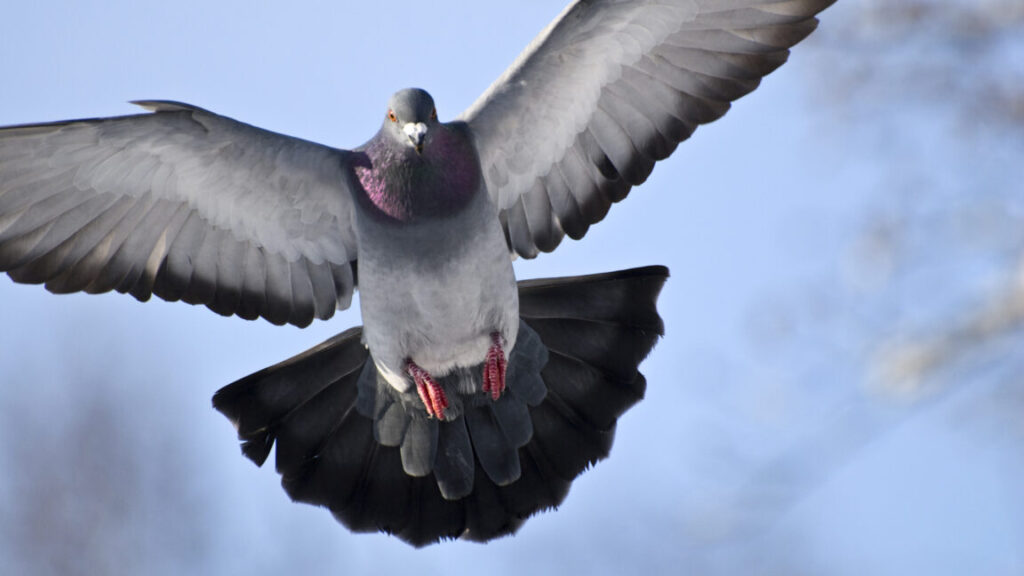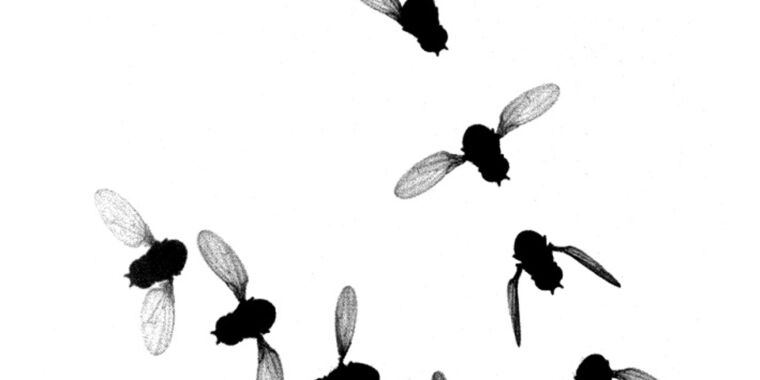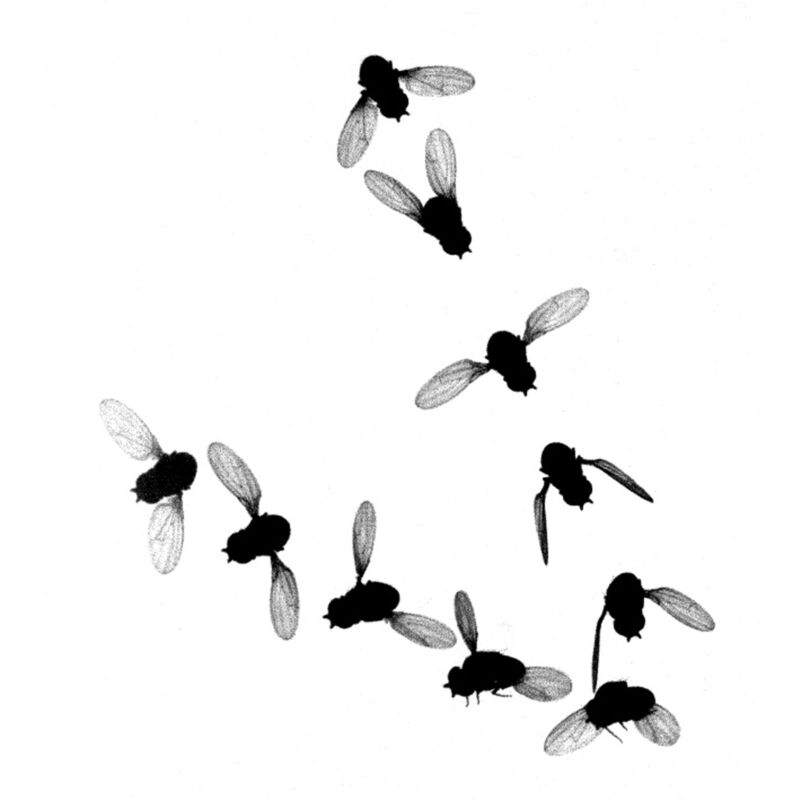Teaching a drone to fly without a vertical rudder
We can get a drone to fly like a pigeon, but we needed to use feathers to do it.
Pigeons manage to get vertical without using a vertical tail. Credit: HamidEbrahimi
Most airplanes in the world have vertical tails or rudders to prevent Dutch roll instabilities, a combination of yawing and sideways motions with rolling that looks a bit like the movements of a skater. Unfortunately, a vertical tail adds weight and generates drag, which reduces fuel efficiency in passenger airliners. It also increases the radar signature, which is something you want to keep as low as possible in a military aircraft.
In the B-2 stealth bomber, one of the very few rudderless airplanes, Dutch roll instabilities are dealt with using drag flaps positioned at the tips of its wings, which can split and open to make one wing generate more drag than the other and thus laterally stabilize the machine. “But it is not really an efficient way to solve this problem,” says David Lentink, an aerospace engineer and a biologist at the University of Groningen, Netherlands. “The efficient way is solving it by generating lift instead of drag. This is something birds do.”
Lentink led the study aimed at better understanding birds’ rudderless flight mechanics.
Automatic airplanes
Birds flight involves near-constant turbulence—“When they fly around buildings, near trees, near rocks, near cliffs,” Lentink says. The leading hypothesis on how they manage this in a seemingly graceful, effortless manner was suggested by a German scientist named Franz Groebbels. He argued that birds’ ability relied on their reflexes. When he held a bird in his hands, he noticed that its tail would flip down when the bird was pitched up and down, and when the bird was moved left and right, its wings also responded to movement by extending left and right asymmetrically. “Another reason to think reflexes matter is comparing this to our own human locomotion—when we stumble, it is a reflex that saves us from falling,” Lentink claims.
Groebbels’ intuition about birds’ reflexes being responsible for flight stabilization was later backed by neuroscience. The movements of birds’ wings and muscles were recorded and found to be proportional to the extent that the bird was pitched or rolled. The hypothesis, however, was extremely difficult to test with a flying bird—all the experiments aimed at confirming it have been done on birds that were held in place. Another challenge was determining if those wing and tail movements were reflexive or voluntary.
“I think one pretty cool thing is that Groebbels wrote his paper back in 1929, long before autopilot systems or autonomous flight were invented, and yet he said that birds flew like automatic airplanes,” Lentink says. To figure out if he was right, Lentink and his colleagues started with the Groebbels’s analogy but worked their way backward—they started building autonomous airplanes designed to look and fly like birds.
Reverse-engineering pigeons
The first flying robot Lentink’s team built was called the Tailbot. It had fixed wings and a very sophisticated tail that could move with five actuated degrees of freedom. “It could spread—furl and unfurl—move up and down, move sideways, even asymmetrically if necessary, and tilt. It could do everything a bird’s tail can,” Lentink explains. The team put this robot in a wind tunnel that simulated turbulent flight and fine-tuned a controller that adjusted the tail’s position in response to changes in the robot’s body position, mimicking reflexes observed in real pigeons.
“We found that this reflexes controller that managed the tail’s movement worked and stabilized the robot in the wind tunnel. But when we took it outdoors, results were disappointing. It actually ended up crashing,” Lentink says. Given that relying on a morphing tail alone was not enough, the team built another robot called PigeonBot II, which added pigeon-like morphing wings.
Each wing could be independently tucked or extended. Combined with the morphing tail and nine servomotors—two per wing and five in the tail—the robot weighed around 300 grams, which is around the weight of a real pigeon. Reflexes were managed by the same controller that was modified to manage wing motions as well.
To enable autonomous flight, the team fitted the robot with two propellers and an off-the-shelf drone autopilot called Pixracer. The problem with the autopilot, though, was that it was designed for conventional controls you use in quadcopter drones. “We put an Arduino between the autopilot and the robot that translated autopilot commands to the morphing tail and wings’ motions of the robot,” Lentink says.
The Pigeon II passed the outdoor flying test. It could take off, land, and fly entirely on its own or with an operator issuing high-level commands like go up, go down, turn left, or turn right. Flight stabilization relied entirely on bird-like reflexes and worked well. But there was one thing electronics could not re-create: their robots used real pigeon feathers. “We used them because with current technology it is impossible to create structures that are as lightweight, as stiff, and as complex at the same time,” Lentink says.
Feathery marvels
Birds’ feathers appear simple, but they really are extremely advanced pieces of aerospace hardware. Their complexity starts with nanoscale features. “Feathers have 10-micron 3D hooks on their surface that prevent them from going too far apart. It is the only one-sided Velcro system in the world. This is something that has never been engineered, and there is nothing like this elsewhere in nature,” Lentink says. Those nanoscale hooks, when locked in, can bear loads reaching up to 20 grams.
Then there are macroscale properties. Feathers are not like aluminum structures that have one bending stiffness, one torque stiffness, and that’s it. “They are very stiff in one direction and very soft in another direction, but not soft in a weak way—they can bear significant loads,” Lentink says.
His team attempted to make artificial feathers with carbon fiber, but they couldn’t create anything as lightweight as a real feather. “I don’t know of any 3D printer that could start with 10-micron nanoscale features and work all the way up to macro-scale structures that can be 20 centimeters long,” Lentink says. His team also discovered that pigeon’s feathers could filter out a lot of turbulence perturbations on their own. “It wasn’t just the form of the wing,” Lentink claims.
Lentink estimates that a research program aimed at developing aerospace materials even remotely comparable to feathers could take up to 20 years. But does this mean his whole concept of using reflex-based controllers to solve rudderless flight hangs solely on successfully reverse-engineering a pigeon’s feather? Not really.
Pigeon bombers?
The team thinks it could be possible to build airplanes that emulate the way birds stabilize rudderless flight using readily available materials. “Based on our experiments, we know what wing and tail shapes are needed and how to control them. And we can see if we can create the same effect in a more conventional way with the same types of forces and moments,” Lentink says. He suspects that developing entirely new materials with feather-like properties would only become necessary if the conventional approach bumps into some insurmountable roadblocks and fails.
“In aerospace engineering, you’ve got to try things out. But now we know it is worth doing,” Lentink claims. And he says military aviation ought to be the first to attempt it because the risk is more tolerable there. “New technologies are often first tried in the military, and we want to be transparent about it,” he says. Implementing bird-like rudderless flight stabilization in passenger airliners, which are usually designed in a very conservative fashion, would take a lot more research, “It may take easily take 15 years or more before this technology is ready to such level that we’d have passengers fly with it,” Lentink claims.
Still, he says there is still much we can learn from studying birds. “We know less about bird’s flight than most people think we know. There is a gap between what airplanes can do and what birds can do. I am trying to bridge this gap by better understanding how birds fly,” Lentink adds.
Science Robotics, 2024. DOI: 10.1126/scirobotics.ado4535
Teaching a drone to fly without a vertical rudder Read More »



